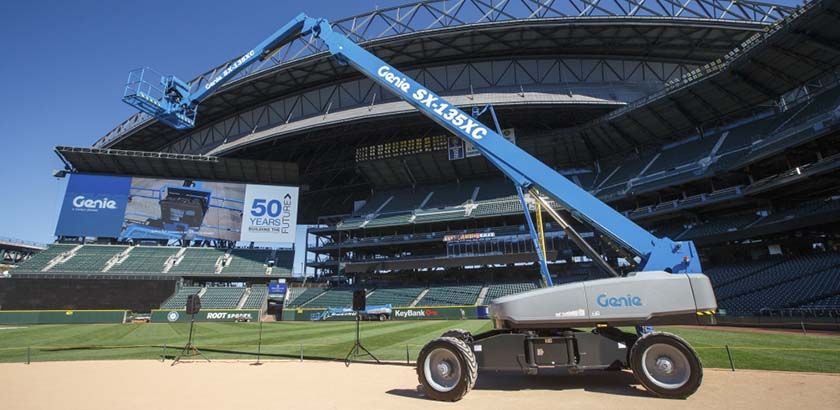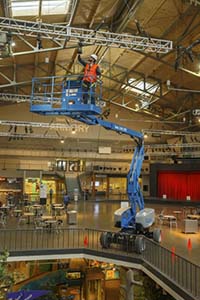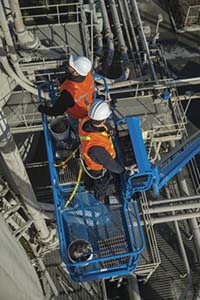What Constitutes Proper MEWP Training?

One of the biggest challenges facing our industry today is how to increase awareness about why safety training is so important. As the industry is preparing to implement the pending ANSI and the approved CSA standards changes, companies need to understand their responsibilities regarding training requirements for mobile elevated work platforms (MEWPs). And, this understanding cannot be limited to what they’re required by law and enforced by OSHA to do, but that they know there are very good reasons for the training to keep their operators safe.
 Today, many companies are facing the dilemma of how to ensure that their operators are receiving proper training. They are aware that ensuring that their operators, and personnel, are properly trained is one of the first steps in helping to prevent accidents yet are unsure of how to go about it.
Today, many companies are facing the dilemma of how to ensure that their operators are receiving proper training. They are aware that ensuring that their operators, and personnel, are properly trained is one of the first steps in helping to prevent accidents yet are unsure of how to go about it.
Becoming a trained and qualified MEWP operator is very similar to getting a driver’s license. It is not something that can be accomplished in a short 30-45 minute familiarization prior to getting to work. Training new operators how to operate the machine requires much more than a familiarization exercise. The goal of training is for a person to become a qualified operator, and it must include proper instruction and guidance from a qualified trainer with either classroom or online instruction. It also must include an in-depth, in-person, hands-on component that involves practicing operation with a qualified trainer instructing safe use best practices and ways to be most productive.
As mentioned previously, training is mandated by industry standards. It is important to know what regional standards say needs to be covered in an operator training course. For example, both the ANSI A92 and CSA B354 standards state that users need to discuss the purpose and use of the operating and safety manuals, as well as ensure that operating personnel are aware that those manuals are an integral part of the MEWP. The standards also state that these manuals must be stored properly in a weather-resistant compartment when not in use.
Pre-Start Inspections
The standards also require that users have to cover how to properly perform a pre-start or pre-operation inspection, including performing function tests on the machine prior to each shift (or prior to use by a different operator within the same shift). The responsibilities associated with problems or malfunctions affecting the operation of the MEWP must also be discussed so that the operator knows what to do if something goes wrong.
What else? Per the standards, factors that affect stability are critical and must be reviewed in depth. For example, an operator needs to be able to recognize hazards and take appropriate steps to avoid those hazards. When it comes to proper safe use practices, 50/50 chance is unacceptable.
The standards also require that operators understand the purpose of the placards and decals on the machine, as well as know the importance of why these materials must be read and adhered to at all times. Much like the placards and decals, manufacturer-provided operator warnings and instructions are critical and must be followed too. Keep in mind that every manufacturer does things differently, which reinforces the need for the operator to be familiarized on the MEWP he or she will be operating.
Workplace Inspections
The process of performing a proper workplace inspection is critical to the safe operation of a MEWP. It isn’t simply a matter of looking around for the obvious. These inspections must identify every hazard on the jobsite, including what is under the ground, before moving the machine into place. Then, it is up to the operators to remember and avoid those hazards through all phases of operation.
Safety rules and regulations must be adhered to at all time, including jobsite, local, regional, provincial and federal. Some jobsites have additional rules and regulations outlined and dictated for operating on-site. ANSI A92 and CSA B354 standards require that those rules and regulations must be understood and followed as well.
Under the standards, users are required to discuss authorization to operate. This means that just because an operator has been trained and qualified does not mean that he/she is authorized to operate MEWP on the jobsite. Only the user may deem them to be authorized before an operator can use a MEWP.
MEWP Operation
Once all of the above has been thoroughly covered, actual operation of the MEWP needs to be addressed in a comprehensive training program. For instance, trainings programs must include a hands-on practical experience operating the MEWP, for a sufficient period of time, in order for the operator, or trainee, to demonstrate proficiency in the actual operation of the machine.
Training
Proper operator training, including the hands-on practical training, cannot be performed in less than three hours, at a minimum. Often longer is needed for operators to feel comfortable and confident with the MEWP. In fact, the Statement of Best Practice of General Training and Familiarization for Aerial Work Platform Equipment* states that General Training should take 3-6 hours or more, depending upon the class size and number of equipment classifications to be covered. It goes on to state that machine familiarization should take 15 to 60 minutes or more, depending upon the model.
Yet, there is an alarming trend in our industry of 30-45 minute “operator training” sessions in the field. This trend is in an effort to get operators out on jobsites and working as quickly as possible. But in reality, these shorter sessions are only performing machine familiarization sessions, and in many cases, these sessions do not even cover a full, proper familiarization training.
Three to six hours may seem like a long time to wait for an operator to be trained and ready to work, but honestly, this what it takes to ensure the safety of the operator, occupants and others working around the machine. The importance of these lengthy trainings is not only ensuring that operators are trained before using MEWPs, but it is to also ensure that they are receiving the highest quality, most current, most relevant and standards-compliant training available.
ready to work, but honestly, this what it takes to ensure the safety of the operator, occupants and others working around the machine. The importance of these lengthy trainings is not only ensuring that operators are trained before using MEWPs, but it is to also ensure that they are receiving the highest quality, most current, most relevant and standards-compliant training available.
When weighing the pros and cons of investing in training, companies should not fall for the quick and easy. Often, those choices come back to haunt companies in more ways than many can imagine. Jobsite safety should be everyone’s number one priority, and doing everything possible to keep jobsites safety is priceless.
There are many good operator training courses out there. Genie, for example, has made it a company mission to not only raise awareness for training, but we are also committed to helping train the industry. We understand the power of training and the need for it. That’s why Genie developed a two-part training program, delivering a standardized MEWP training package, to help operators stay safe and fleet owners reduce their repair costs. Genie® Lift Pro™ Training meets applicable ANSI, OSHA and CSA requirements and includes a Genie Lift Pro aerial access card verifying completion of the training, which is required to become a qualified MEWP operator.
It is important for companies to do their research, to ask trusted sources for recommendations, and then they should select a credible program to partner with to conduct the trainings. Everyone benefits from companies making a knowledgeable, smart decision when it comes to training programs.
* The Statement of Best Practice of General Training and Familiarization for Aerial Work Platform Equipment can be downloaded at:https://shop.aem.org/en/AEM%20Safety/aem-safety-products/Statement-of-Best-Practices-of-General-Training-Familirization-for-AWP-Equip_PDF/
